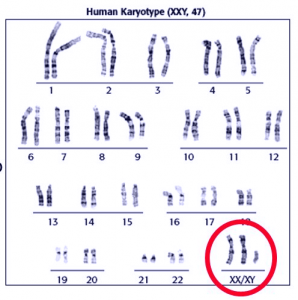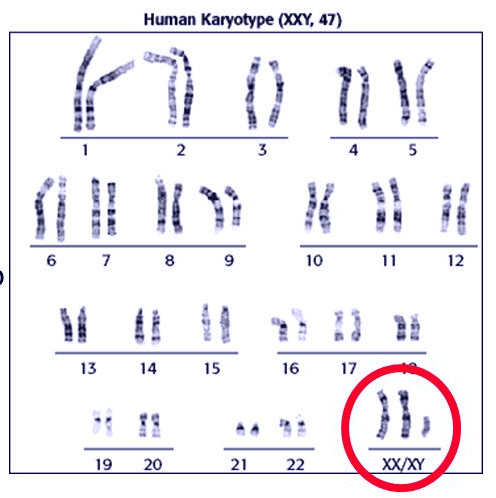Klinefelter’s syndrome is a disorder that arises when an error occurs during cell division, leading to retention of two or more X chromosomes in newborn males. A person affected by Klinefelter syndrome may possess certain female characteristics such as enlarged hips, pronounced breasts, and less muscular body. The condition, whose main symptom is infertility, occurs in 2 out of every 1000 male births worldwide.
Causes
Chromosomes are the structures that house genetic information of an individual. A normal male has one X chromosome and one Y chromosome. The X chromosome is derived from the mother, who has XX chromosomal combination, while the Y chromosome is derived from the father, who has XY chromosomal combination.
In a person with Klinefelter syndrome however, either the father or the mother, or both may contribute an extra X chromosome during fertilization. Therefore, instead of the child having a normal XY combination, he ends up getting XXY or XXXY. This is why the condition is also referred to as the XXY syndrome.

Symptoms of XXY syndrome
While reduced fertility is a universal occurrence in XXY, there are other symptoms that appear only in some patients. They include the following:
Reduced size of sex organs
During puberty, sex organs in normal males increase in size in order to enable them perform their reproductive functions. Sex hormones, whose manufacture and release are controlled by the brain, are responsible for this development.
In individuals with Klinefelter syndrome however, the brain’s ability to coordinate sex hormones is partially or completely diminished, and this leads to poor development of sex organs. With this comes the problem infertility.
Reduced executive functions
Executive functions are common mental abilities such as memory retention, attention, planning, and reasoning. Due to reduced mental capacity to learn such tasks quickly, a child with XXY may find difficulties in catching up with others in class. Reading and speaking may also be impaired. Fortunately, in most cases, these issues can be corrected.
Feminineness
Feminine features in Klinefelter’s syndrome patients appear mostly during adolescence. These may include broadening of hips and buttocks, emergence of breast tissue, and smoothening of skin.
While these patients are more prone to diseases like breast cancer, lupus, and deep vein thrombosis, they are generally less affected by other women- related diseases.
Weakness
More people with XXY tend to experience muscle weakness compared to the general population. This reduces stability in crawling, walking or running. Writing or drawing may also take longer to learn.
Due to their increased height and low testosterone production, these patients usually have low bone density. As they age, they develop a condition known as osteoporosis, which is characterized by a bent back and fragile bones.
Who is susceptible to Klinefelter’s syndrome?
Any parent can give birth to a child with this condition. However, studies have shown that elderly couples are more likely to bear such children compared to young couples.
Klinefelter’s syndrome is not an inheritable condition; neither can it spread from one individual to another.
Treatment
There is no specific treatment for this condition. However, the symptoms can be well managed, and with early intervention, most XXY patients live normal lives.
Counseling, physiotherapy, and speech therapy are required for patients exhibiting communication and coordination difficulties. Extra coaching for children with Klinefelter syndrome has also shown improved performance in class work and in sports.
To reduce the risk of osteoporosis or delay its onset, regular exercise and proper diet should be adhered to. Foods rich in calcium, vitamin D and Vitamin K help to improve bone strength. Hormonal injections may also improve bone density, though these sometimes produce negative effects that some experts think outweigh their benefits.
While a few XXY patients are completely sterile, majority are still able to produce viable sperms.
With help of In Vitro Fertilization, they can successfully give birth to healthy babies. During the procedure, the surgeon dissects the testes to extract sperm cells. A healthy sperm is then injected into an ovum. Afterwards the fertilized egg is transferred into the uterus, where it develops.
Because of the psychosocial problems that may result from having breasts, disturbed patients can opt to get these tissues surgically removed.
Klinefelter Syndrome – Life Expectancy
Generally, individuals suffering from this condition live to nearly the same age as healthy people.
However, early death can result from iatrogenesis (complications arising from medicinal or cultural interventions, like surgeries or extreme rituals).
Without effective counseling and support from family and friends, some patients may also succumb from depression, or may commit suicide.
To manage Klinefelter’s syndrome therefore, a holistic approach is necessary. Treatments should aim at improving self-esteem of the individual as well as improving their ability to perform daily living activities efficiently. Because methods like surgery carry potential risks, they should only be pursued when necessary.Just like everyone else, patients should be accorded proper diet, exercise and adequate rest.

